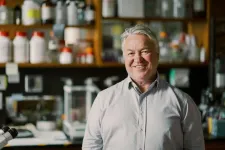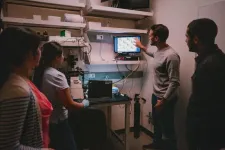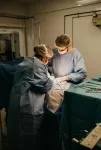(Press-News.org) Using a novel stem cell platform, a team of Medical University of South Carolina researchers has identified a pathway that could be targeted by drugs to reduce fat accumulation in patients with a common form of fatty liver disease known as metabolic dysfunction-associated steatotic liver disease, or MASLD. The MUSC team was led by Stephen Duncan, Ph.D., SmartState Endowed Chair in Regenerative Medicine at MUSC, and Caren Doueiry, an M.D., Ph.D. candidate in Duncan’s laboratory. The team reports its findings in the International Journal of Molecular Sciences.
Almost a quarter of Americans have MASLD, formerly known as non-alcoholic fatty liver disease. It is estimated that three in four people who are overweight and as many as two in three patients with Type 2 diabetes have the disease. In MASLD, fat accumulates over time in the liver, leading to fibrosis, or scarring of the liver, as well as cancer. In fact, MASLD is the leading cause of hepatocellular carcinoma, the most common primary liver cancer in adults.
Understanding MASLD using stem cells
Stem cells are a group of cells that have not yet determined what types of cells they will become. During early development, they respond to signals in their environment that guide them to differentiate into specific cell types, such as liver, nerve or muscle cells.
Scientists have developed technologies that enable them to take blood samples from patients and erase the specialized markers that make them blood cells. These reprogrammed cells are called induced pluripotent stem cells (iPSCs), and they serve as a blank canvas for scientists, who can instruct them to become any type of cell they wish to study. This technology allows these cells to organize into complex tissues and organs, providing a deeper understanding of the human body.
Doueiry used CRISPR, a gene-editing tool, to engineer a line of iPSCs with a mutation in the PNPLA3 gene that is common in patients with MASLD. CRISPR stands for clustered regularly interspaced short palindromic repeats.
“A lot of patients with fatty liver have this mutation, and we don’t know what it’s doing or why it’s increasing susceptibility to fatty liver,” said Doueiry, lead author of the article.
To learn more about the mutation’s role in MASLD, Doueiry induced the iPSCs carrying the mutation to become liver cells. She observed that the mutated liver cells had higher levels of fat accumulation. This finding links this common genetic mutation to a key characteristic of MASLD, showing that it plays an important role in regulating fat accumulation in the liver.
Doueiry is most excited that she now has a model that mirrors the human disease right in a cell culture plate.
“I knew that the mutation in humans was causing the fat accumulation, but I had no idea what I was going to see in the plate,” she said. “Looking at the liver cells carrying the genetic mutation for the first time was so exciting because I knew we had a model that we can use to find some answers.”
Searching for compounds to reduce fat build-up in the liver
No current pharmaceutical treatments target the excess fat accumulation that leads to MASLD. To look for potential contenders, Doueiry screened 1,100 small molecules from a library of compounds to see which ones reduced fat accumulation in her genetically modified liver cells. After a series of screens, Doueiry was able to identify five compounds that more than halved the number of fat droplets on the treated liver cells.
Surprisingly, these compounds all interacted with proteins in the same cellular pathway. Even more remarkably, this cellular pathway is known to regulate cell growth and is commonly targeted by cancer therapeutics to stop tumor development. Several approved cancer drugs that inhibit proteins in this pathway are already being administered to patients. When Doueiry used cancer drugs to treat her genetically modified liver cells, fat accumulation dramatically decreased, just as it had with the five compounds she initially discovered.
“With these results, we knew we weren’t just looking at random molecules doing something. The fact that they all connected through a pathway showed us that we were onto something,” she explained.
Doueiry was even able to use her models to determine the appropriate drug dosage needed to achieve this therapeutic effect with minimal unwanted effects. She discovered that a low dose of the inhibitor was sufficient to lower fat accumulation in liver cells lacking the mutation, with little effect on cell viability, promising findings for future clinical studies.
In short, Doueiry’s iPSC disease model not only mimicked the disease in the laboratory but also provided a better sense of how human cells would respond to treatment. It showed that low dosages of selected pathway inhibitors achieved a good response, with few unwanted effects.
Duncan is excited about the potential of this new model.
“Caren’s study has shown that human stem cell-derived liver cells with MASLD mutations can be used effectively to identify pathways that can be targeted by drugs to reduce fat levels in the liver,” said Duncan.
What does this mean for patients with MASLD?
This study’s finding suggests that MASLD, particularly when caused by this common genetic mutation, could one day be a treatable condition, possibly using repurposed already-approved drugs.
Though much work remains before a pharmaceutical treatment reaches the clinic, Duncan and Doueiry’s work inspires hope – not just for patients with MASLD but also for the potential of iPSCs to serve as models for screening therapeutics for other genetically linked diseases.
# # #
About MUSC
Founded in 1824 in Charleston, MUSC is the state’s only comprehensive academic health system, with a unique mission to preserve and optimize human life in South Carolina through education, research and patient care. Each year, MUSC educates more than 3,200 students in six colleges – Dental Medicine, Graduate Studies, Health Professions, Medicine, Nursing and Pharmacy – and trains more than 900 residents and fellows in its health system. MUSC brought in more than $358.9 million in research funds in fiscal year 2024, leading the state overall in research funding. MUSC also leads the state in federal and National Institutes of Health funding. For information on academic programs, visit musc.edu.
As the health care system of the Medical University of South Carolina, MUSC Health is dedicated to delivering the highest-quality and safest patient care while educating and training generations of outstanding health care providers and leaders to serve the people of South Carolina and beyond. Patient care is provided at 16 hospitals (includes owned or governing interest), with approximately 2,700 beds and five additional hospital locations in development, more than 350 telehealth sites and nearly 750 care locations situated in all regions of South Carolina. In 2024, for the 10th consecutive year, U.S. News & World Report named MUSC Health University Medical Center in Charleston the No. 1 hospital in South Carolina. To learn more about clinical patient services, visit muschealth.org.
MUSC has a total enterprise annual operating budget of approximately $7.1 billion. The 31,000 MUSC family members include world-class faculty, physicians, specialty providers, scientists, students, contract employees, affiliates and care team members who deliver groundbreaking education, research and patient care.
END
Finding the right path(way) to reduce fat accumulation in the liver
Using a novel model for a common fatty liver disease, a Medical University of South Carolina team has identified a pathway that could be targeted by a drug to reduce fat accumulation in the liver
2024-09-10
ELSE PRESS RELEASES FROM THIS DATE:
MicroDicer and MicroGrater make quick work of tumor dissection
2024-09-10
As fascinating as it is to work in a modern biology lab, in many cases a lot of repetitive, detailed work is necessary before the research can start. For example, cancer researchers are now capable of using hundreds or even thousands of small, lab-grown tumor samples – known as organoids – to test multiple cancer therapies, including immunotherapies, at once.
To produce organoids, researchers often need to mince a fresh tumor into small pieces by hand, using scissors to snip, snip, snip the specimen down to submillimeter size. This dissection work is tedious and yet often done by skilled – and usually overqualified ...
Phase II study of taletrectinib shows clinically meaningful overall response and favorable safety in patients with ROS1+ non-small cell lung cancer
2024-09-10
(San Diego, Calif.--September 10, 2024, 10:35 a.m. PCT) – The ROS1 tyrosine kinase inhibitor (TKI) taletrectinib demonstrated high overall and intracranial responses, and a favorable safety profile with low incidence of neurologic adverse events in TKI-naive and TKI-pretreated patients with ROS1+ non-small cell lung cancer (NSCLC).
These results were presented today at the International Association for the Study of Lung Cancer 2024 World Conference on Lung Cancer by Dr. Geoffrey Liu, from Princess Margaret Cancer Centre, ...
LUMINOSITY trial demonstrates telisotuzumab vedotin shows durable response in Asian patients with c-Met protein-overexpressing EGFR WT nonsquamous NSCLC
2024-09-10
LUMINOSITY Trial Demonstrates Telisotuzumab Vedotin Shows Durable Response in Asian Patients with c-Met Protein-Overexpressing EGFR WT Nonsquamous NSCLC
(San Diego, Calif.--September 10, 2024 10:35 a.m.) -- The c-Met-directed antibody-drug conjugate telisotuzumab vedotin demonstrated durable responses and an acceptable safety profile in patients of Asian race with c-Met protein-overexpressing, epidermal growth factor receptor (EGFR) wildtype (WT), locally advanced/metastatic nonsquamous non-small cell ...
PM2.5 exposure may affect lung cancer in women who have never smoked
2024-09-10
(San Diego, Calif.--September 10, 2024, 10:35 a.m. PCT) – Recent air pollution exposure in the form of particles smaller than 2.5 micrometers (PM2.5) exposure may significantly impact lung cancer in women who have never smoked, with notable differences in stage IV diagnoses among EGFR+ patients, according to research presented today at the International Association for the Study of Lung Cancer (IASLC) 2024 World Conference on Lung Cancer.
The International Agency for Research on Cancer (IARC) categorized outdoor air pollution and its key component, particulate matter PM2.5, as Group 1 carcinogens in 2013, indicating that they cause lung cancer. Associations between ...
Results from CARMEN-LC03 phase 3 study of tusamitamab ravtansine vs. docetaxel in previously treated advanced non-squamous NSCLC presented at WCLC 2024
2024-09-10
(San Diego, Calif.--September 10, 2024, 10:35 a.m. PCT) A phase 3 study comparing tusamitamab ravtansine with docetaxel in patients with advanced non-squamous non-small cell lung cancer (NSCLC) previously treated with platinum-based chemotherapy and immunotherapy (in combination or sequential), whose tumors highly expressed CEACAM5, is presented today at the International Association for the Study of Lung Cancer 2024 World Conference on Lung Cancer in San Diego, Calf., by Dr. Benjamin Besse of Gustave Roussy, in Paris, France. As previously announced by Sanofi in December 2023, ...
Partial knee replacements for osteoarthritis performed by trainee surgeons last as long as those performed by more experienced consultants
2024-09-10
Partial knee replacements for osteoarthritis performed by trainee surgeons last as long as those performed by more experienced consultants, according to data from England and Wales suggesting no difference in rates of subsequent revision surgery
#####
In your coverage, please use this URL to provide access to the freely available paper in PLOS Medicine: http://journals.plos.org/plosmedicine/article?id=10.1371/journal.pmed.1004445
Article Title: Association between surgeon training grade and the risk of revision following unicompartmental knee replacement: ...
New Zealand’s kākāpō developed different feather colors to evade predatory birds
2024-09-10
Aotearoa New Zealand’s flightless parrot, the kākāpō, evolved two different color types to potentially help them avoid detection by a now-extinct apex predator, Lara Urban at Helmholtz AI, Germany and colleagues from the Aotearoa New Zealand Department of Conservation and the Māori iwi Ngāi Tahu, report in the open-access journal PLOS Biology, publishing September 10th.
The kākāpō (Strigops habroptilus) is a nocturnal, flightless parrot endemic to New Zealand. It experienced severe population ...
Unaffordable food putting mums-to-be at risk
2024-09-10
Embargoed until Tuesday September 10 at 19:00 (BST)
Pregnant women who have limited access to affordable, nutritious, and healthy foods have a higher chance of developing both physical and mental health problems.
New research from Newcastle University has found that women who are what is termed “food insecure” are up to four times more likely to have poor mental health - such as stress, anxiety, and depression - than those who don’t struggle to afford or access food.
The mums-to-be are also at increased risk of obesity, developing diabetes during their pregnancy and dental problems, the two studies published ...
Viruses to enhance crop performance
2024-09-10
Humans, livestock and companion animals benefit from virus-based vaccines and gene therapies, but crops do not. This paradox is highlighted by an international research group led by the Institute of Molecular and Cellular Biology of Plants (IBMCP) within the Spanish National Research Council (CSIC), in an article published in the prestigious journal Nature Reviews Bioengineering. The study proposes a roadmap to use attenuated viruses to enhance performance of crops, making them more resistant to extreme and changing climate ...
Pharmacy benefit manager market concentration for prescriptions filled at US retail pharmacies
2024-09-10
About The Study: In 2023, all 3 payer markets (commercial insurance, Medicare Part D, and Medicaid managed care) for pharmacy benefit manager (PBM) services were highly concentrated, but concentration varied and was highest in Medicare Part D. While CVS Caremark held the dominant share in all 3 payer markets, each of the PBMs appeared focused on a different payer: Express Script’s largest share was in the commercial market, while Optum Rx’s and CVS Caremark’s were in Medicare Part D and Medicaid ...
LAST 30 PRESS RELEASES:
Rice establishes Global Brain Economy Initiative in Davos, aligned with new report on brain health and AI
Quantum error correction with logical qubits
Nutrient-stimulated hormone-based therapies: A new frontier in the prevention and management of MASH-associated hepatocellular carcinoma
Trauma or toxic? A deep dive into the impact of stress on kids' health
Turning industrial exhaust into useful materials with a new electrode
ORNL to partner with Type One Energy, UT on world-class facility to validate next-gen fusion
New journal section tackles AI, ethics, and digital health communication
Jeonbuk National University researchers develop novel dual-chemical looping method for efficient ammonia synthesis
New study sheds light on stroke recovery via exercise-induced migration of mitochondria
SEOULTECH researchers develop sodium-based next-generation smart electrochromic windows
Data-driven analysis reveals three archetypes of armed conflicts
Heart disease, stroke deaths down, yet still kill more in US than any other cause
Light switches made of ultra-thin semiconductor layers
Creative talent: has AI knocked humans out?
Sculpting complex, 3D nanostructures with a focused ion beam
A year after undermining Bredt’s rule, UCLA scientists have made cage-shaped, double-bonded molecules that defy expectations
Human activities drive global dryland greening
PeroCycle announces new appointments as it builds a world-class board for meaningful climate impact
Magnetic avalanches power solar flares
LeapSpace goes live: the Research-Grade AI-Assisted Workspace built on trusted science
DNA tests reveal mysterious beluga family trees
Strategic sex: Alaska’s beluga whales swap mates for long-term survival
How early cell membranes may have shaped the origins of life
Cannabis legalization is driving increases in marijuana use among U.S. adults with historically lower consumption rates
Multifunctional dipoles enabling enhanced ionic and electronic transport for high‑energy batteries
Triboelectric nanogenerators for future space missions
Advancing energy development with MBene: Chemical mechanism, AI, and applications in energy storage and harvesting
Heteroatom‑coordinated Fe–N4 catalysts for enhanced oxygen reduction in alkaline seawater zinc‑air batteries
Meta-device for precision lateral displacement sensing
Plasma-guided mitotane for the treatment of adrenocortical carcinoma: adjuvant care to advanced disease
[Press-News.org] Finding the right path(way) to reduce fat accumulation in the liverUsing a novel model for a common fatty liver disease, a Medical University of South Carolina team has identified a pathway that could be targeted by a drug to reduce fat accumulation in the liver








